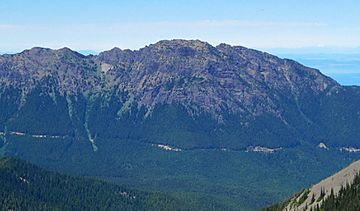Rocky Peak (Washington) facts for kids
Quick facts for kids Rocky Peak |
|
|---|---|

Rocky Peak seen from Eagle Point
|
|
| Highest point | |
| Elevation | 6,218 ft (1,895 m) |
| Prominence | 538 ft (164 m) |
| Geography | |
| Location | Clallam County, Washington, US |
| Parent range | Olympic Mountains |
| Topo map | USGS Mount Angeles |
| Geology | |
| Age of rock | Eocene |
| Climbing | |
| Easiest route | Scrambling class 3 |
Rocky Peak is a mountain peak in the Olympic Mountains. It stands about 6,218 feet (1,895 meters) tall. This peak is found in Clallam County, Washington state.
It is located about eight miles south of Port Angeles, Washington. Rocky Peak is also inside Olympic National Park. The mountain's closest taller neighbor is Mount Angeles, which is about 1.87 miles (3.01 km) to the west. Klahhane Ridge connects these two peaks.
Many people visit the area using the scenic Hurricane Ridge Road. This road goes along the lower south side of Rocky Peak. Local people named the mountain Rocky Peak a long time ago. Water from the north side of the peak flows into Rocky Creek. Water from the south side flows into Morse Creek. Both creeks eventually reach the Strait of Juan de Fuca.
Mountain Weather
Rocky Peak is in the north-central part of the Olympic Mountains. This area has a marine west coast climate. This means it gets a lot of rain and mild temperatures.
Most weather systems start over the Pacific Ocean. They then move northeast towards the Olympic Mountains. When these weather systems hit the tall mountains, they are forced to rise. This causes them to drop their moisture as rain or snow. This process is called orographic lift.
Because of this, the Olympic Mountains get a lot of rain and snow. This is especially true during the winter months. Winters are usually cloudy. However, during summer, high-pressure systems over the Pacific Ocean often bring clear skies. The snow here tends to be wet and heavy. This can sometimes create a risk of snow slides.
How the Mountains Formed
The Olympic Mountains are made of different types of rock. These include Eocene sandstone, turbidite, and basalt. These rocks were pushed up from the ocean floor a very long time ago.
The mountains got their shape during the Pleistocene era. This was a time when large sheets of ice, called glaciers, covered much of the Earth. These glaciers moved back and forth many times. As they moved, they carved out the valleys and peaks we see today.
Images for kids





